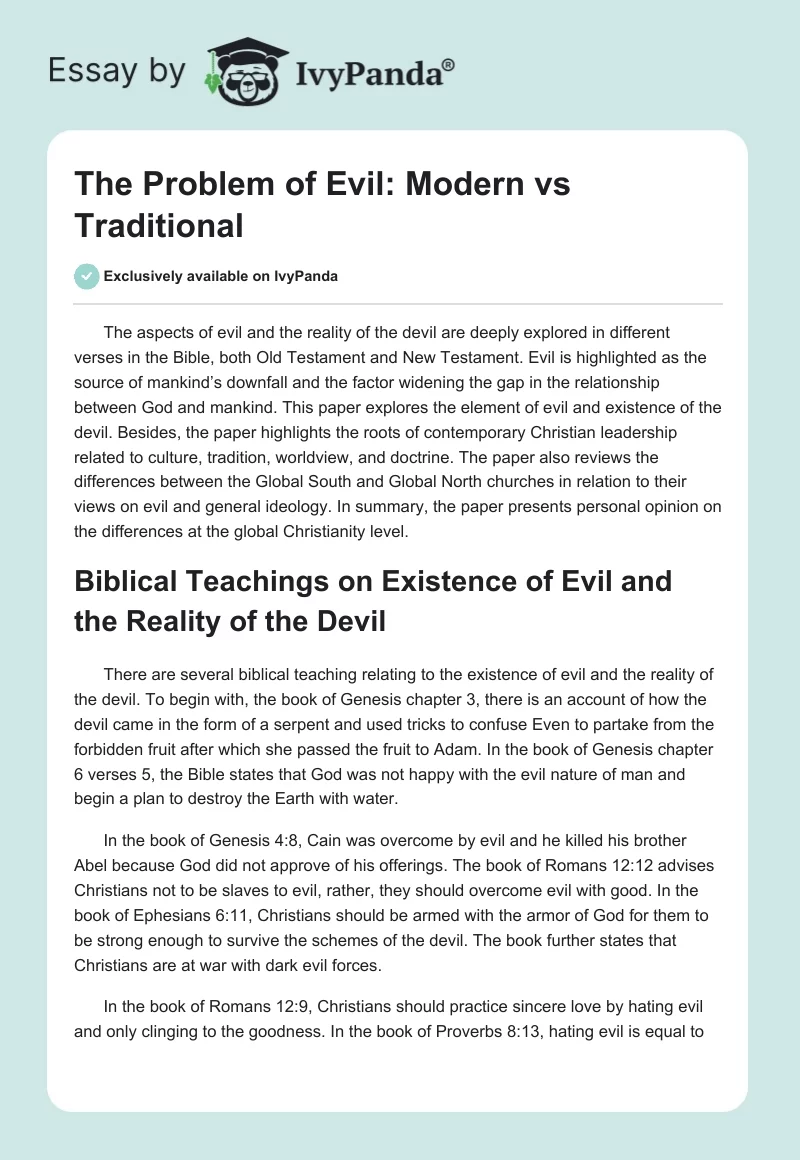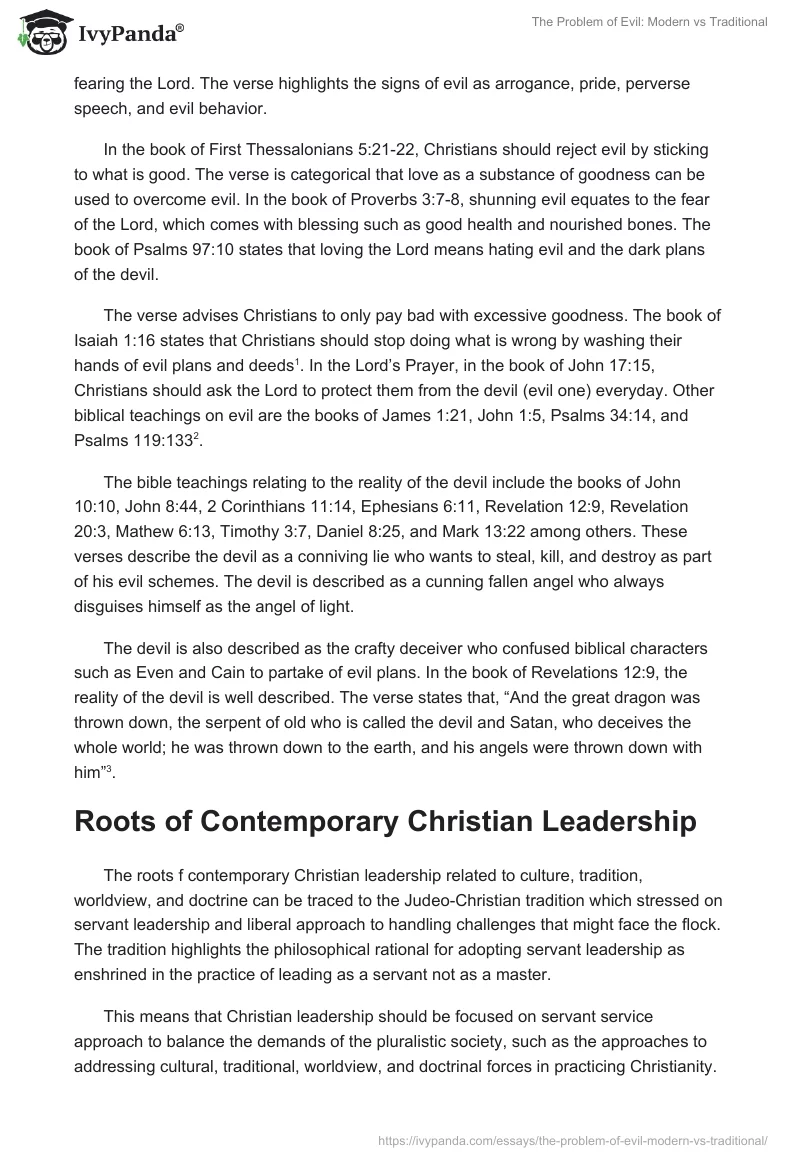The aspects of evil and the reality of the devil are deeply explored in different verses in the Bible, both Old Testament and New Testament. Evil is highlighted as the source of mankind’s downfall and the factor widening the gap in the relationship between God and mankind. This paper explores the element of evil and existence of the devil. Besides, the paper highlights the roots of contemporary Christian leadership related to culture, tradition, worldview, and doctrine. The paper also reviews the differences between the Global South and Global North churches in relation to their views on evil and general ideology. In summary, the paper presents personal opinion on the differences at the global Christianity level.
Biblical Teachings on Existence of Evil and the Reality of the Devil
There are several biblical teaching relating to the existence of evil and the reality of the devil. To begin with, the book of Genesis chapter 3, there is an account of how the devil came in the form of a serpent and used tricks to confuse Even to partake from the forbidden fruit after which she passed the fruit to Adam. In the book of Genesis chapter 6 verses 5, the Bible states that God was not happy with the evil nature of man and begin a plan to destroy the Earth with water.
In the book of Genesis 4:8, Cain was overcome by evil and he killed his brother Abel because God did not approve of his offerings. The book of Romans 12:12 advises Christians not to be slaves to evil, rather, they should overcome evil with good. In the book of Ephesians 6:11, Christians should be armed with the armor of God for them to be strong enough to survive the schemes of the devil. The book further states that Christians are at war with dark evil forces.
In the book of Romans 12:9, Christians should practice sincere love by hating evil and only clinging to the goodness. In the book of Proverbs 8:13, hating evil is equal to fearing the Lord. The verse highlights the signs of evil as arrogance, pride, perverse speech, and evil behavior.
In the book of First Thessalonians 5:21-22, Christians should reject evil by sticking to what is good. The verse is categorical that love as a substance of goodness can be used to overcome evil. In the book of Proverbs 3:7-8, shunning evil equates to the fear of the Lord, which comes with blessing such as good health and nourished bones. The book of Psalms 97:10 states that loving the Lord means hating evil and the dark plans of the devil.
The verse advises Christians to only pay bad with excessive goodness. The book of Isaiah 1:16 states that Christians should stop doing what is wrong by washing their hands of evil plans and deeds. In the Lord’s Prayer, in the book of John 17:15, Christians should ask the Lord to protect them from the devil (evil one) everyday. Other biblical teachings on evil are the books of James 1:21, John 1:5, Psalms 34:14, and Psalms 119:133.
The bible teachings relating to the reality of the devil include the books of John 10:10, John 8:44, 2 Corinthians 11:14, Ephesians 6:11, Revelation 12:9, Revelation 20:3, Mathew 6:13, Timothy 3:7, Daniel 8:25, and Mark 13:22 among others. These verses describe the devil as a conniving lie who wants to steal, kill, and destroy as part of his evil schemes. The devil is described as a cunning fallen angel who always disguises himself as the angel of light.
The devil is also described as the crafty deceiver who confused biblical characters such as Even and Cain to partake of evil plans. In the book of Revelations 12:9, the reality of the devil is well described. The verse states that, “And the great dragon was thrown down, the serpent of old who is called the devil and Satan, who deceives the whole world; he was thrown down to the earth, and his angels were thrown down with him”.
Roots of Contemporary Christian Leadership
The roots f contemporary Christian leadership related to culture, tradition, worldview, and doctrine can be traced to the Judeo-Christian tradition which stressed on servant leadership and liberal approach to handling challenges that might face the flock. The tradition highlights the philosophical rational for adopting servant leadership as enshrined in the practice of leading as a servant not as a master.
This means that Christian leadership should be focused on servant service approach to balance the demands of the pluralistic society, such as the approaches to addressing cultural, traditional, worldview, and doctrinal forces in practicing Christianity. For instance, the book of 1 Timothy 3:1-7 highlights the qualities of a servant leader in the church as being sober minded, respectable, above reproach, and gentle. However, despite possessing these traits, a servant leader in the church is likely to face the challenge from the flock members who are fox in sheep clothing.
The attempt to balance the conflicting interests is informed by the need to manage the “myriad of worldviews compete for attention, where it is assumed that there will be a separation between religion and public life, and where a logical framework for the inclusion of religious values in everyday life is missing”. This situation is necessary “since separation flows from presuppositions fueled by a fragmented modern worldview”.
In practicing servant leadership, there is need to integrate the virtue by using moral pillar to gauge decision making with the agape love, service, altruism, and humility. The moral pillar should be accompanied by trust and a clear vision to guarantee practical application in the dynamic Christianity environment. For instance, in practicing traditional Christian virtues, it is necessary to integrate virtue and humility to avoid conflicts in a perfect teleology. Through this approach, the book of 1 Peter 5:3 notes that the servant leader will be a good example to the flock since he will not have the tendency to domineer over the subjects.
Key Elements that Account for the Significant Differences in Defining Evil: Global North and South Churches
At present, “many Global South Christians are more conservative in terms of both beliefs and moral teaching than are the mainstream churches of the Global North and this is especially true in Africa”. Since the Global South churches are dominated by the Pentecostal and Catholic denominations, most South Christians operate in the medieval faith characterized by collective appreciation of righteousness as compared to the moderate and liberal Christians of the Global North churches.
The members of Global South churches have a “stronger affinity to the sections of the Bible that regard the secular state coldly, that present suffering as the likely lot of the Christian in this life” in the fight against evil. On the other hand, the Global North churches have open view of evil as coexisting with mankind but should be regulated. Besides, the Global South churches view evil at national level while the Global North churches view sin at individual level.
Person Reflection
I do not expect the marked differences to lessen over time since the two church dispensations operate in different environments and doctrinal thoughts. For instance, in the Global South churches, poverty and suffering are high and bound to rise further due to inability of the state to create a good environment for economic and social living. For instance, the churches in Africa and Asia, which are part of the Global South Christianity, have group visions and belief systems that appeal to communal approach to understanding the life of a Christian through suffering. This is the opposite in the Global North churches in North America and Europe.
As a result of the different visions, with each church category deploying competing religious orientation, the differences will widen. Besides, the Global South churches are inspired by liberation that is currently lacking in the Global North churches where political and social activism has taken the back seat. Little is being done by the better developed Global North churches to bridge the sexual and moral indecencies that are the core principles of the Global South churches. Thus, due to differences in vision and perceptions towards moral principles in relation to sex and evil, I would suggest that there will be no integration of the Global North and Global South churches in the near future.
Bibliography
Jenkins, Philip. “Believing in the Global South.” Fist Things Post, 2006. Web.
Stewart, Don. “What Does the Bible Say About the Problem of Evil?” Blue Letter Post. 2014. Web.


